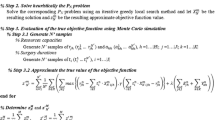Abstract
We present an iterative cutting plane method for minimizing staffing costs in a service system subject to satisfying acceptable service level requirements over multiple time periods. We assume that the service level cannot be easily computed, and instead is evaluated using simulation. The simulation uses the method of common random numbers, so that the same sequence of random phenomena is observed when evaluating different staffing plans. In other words, we solve a sample average approximation problem. We establish convergence of the cutting plane method on a given sample average approximation. We also establish both convergence, and the rate of convergence, of the solutions to the sample average approximation to solutions of the original problem as the sample size increases. The cutting plane method relies on the service level functions being concave in the number of servers. We show how to verify this requirement as our algorithm proceeds. A numerical example showcases the properties of our method, and sheds light on when the concavity requirement can be expected to hold.
Similar content being viewed by others
References
Akşin, O.Z. and P.T. Harker. (2001). “Modeling a Phone Center: Analysis of a Multichannel, Multiresource Processor Shared Loss System.” Management Science 47(2), 324-336.
Bazaraa, M.S., H.D. Sherali, and C.M. Shetty. (1993). Nonlinear Programming: Theory and Algorithms. New York: Wiley.
Benders, J.F. (1962). “Partitioning Procedures for Solving Mixed-Variables Programming Problems.” Numerische Mathematik 4, 238-252.
Billingsley, P. (1995). Probability and Measure, 3rd ed. New York: Wiley.
Birge, J.R. and F. Louveaux. (1997). Introduction to Stochastic Programming. Springer Series in Operations Research. New York: Springer.
Chen, B.P.K. and S.G. Henderson. (2001). “Two Issues in Setting Call Centre Staffing Levels.” Annals of Operations Research 108(1), 175-192.
Chen, H. and B.W. Schmeiser. (2001). “Stochastic Root Finding via Retrospective Approximation.” IIE Transactions 33(3), 259-275.
Dai, L., C.H. Chen, and J.R. Birge. (2000). “Convergence Properties of Two-Stage Stochastic Programming.” Journal of Optimization Theory and Applications 106(3), 489-509.
Dantzig, G.B. (1954). “A Comment on Edie's “Traffic Delays at Toll Booths”.” Operations Research 2(3), 339-341.
Dyer, M.E. and L.G. Proll. (1977). “On the Validity of Marginal Analysis for Allocating Servers in M/M/c Queues.” Management Science 23(9), 1019-1022.
Glasserman, P. (1991). Gradient Estimation Via Perturbation Analysis. Norwell, MA: Kluwer.
Green, L., P.J. Kolesar, and J. Soares. (2001). “Improving the SIPP Approach for Staffing Service Systems that Have Cyclic Demands.” Operations Research 49(4), 549-564.
Healy, K. and L.W. Schruben. (1991). “Retrospective Simulation Response Optimization.” In B.L. Nelson, W.D. Kelton, and G.M. Clark (eds.), Proceedings of the 1991 Winter Simulation Conference, pp. 901-906. Piscataway, NJ: IEEE.
Henderson, S.G. and A.J. Mason. (1998). “Rostering by Iterating Integer Programming and Simulation.” In D.J. Medeiros, E.F.Watson, J.S. Carson, and M.S.Manivannan (eds.), Proceedings of the 1998 Winter Simulation Conference, pp. 677-683. Piscataway, NJ: IEEE.
Higle, J.L. and S. Sen. (1991). “Stochastic Decomposition: An Algorithm for Two-Stage Stochastic Linear Programs with Recourse.” Mathematics of Operations Research 16, 650-669.
Infanger, G. (1994). Planning under Uncertainty: Solving Large-Scale Stochastic Linear Programs. Danvers, MA: Boyd and Fraser.
Ingolfsson, A. and E. Cabral. (2002). “Combining Integer Programming and the Randomization Method to Schedule Employees.” Research Report No. 02-1, University of Alberta.
Ingolfsson, A., M.A. Haque, and A. Umnikov. (2002). “Accounting for Time-Varying Queueing Effects in Workforce Scheduling.” European Journal of Operational Research 139, 585-597.
Jennings, O.B., A. Mandelbaum, W.A. Massey, and W. Whitt. (1996). “Server Staffing to Meet Time-Varying Demand.” Management Science 42(10), 1383-1394.
Kelley, J.E., Jr. (1960). “The Cutting-Plane Method for Solving Convex Programs.” Journal of the Society for Industrial and Applied Mathematics 8(4), 703-712.
Koole, G. and E. van der Sluis. (2003). “Optimal Shift Scheduling with a Global Service Level Constraint.” IIE Transactions 35(11), 1049-1055.
Law, A.M. and W.D. Kelton. (2000). Simulation Modeling and Analysis, 3rd ed. Boston, MA: McGraw-Hill.
Mehrotra, A., K.E. Murphy, and M.A. Trick. (2000). “Optimal Shift Scheduling: A Branch-and-Price Approach.” Naval Research Logistics 47(3), 185-200.
Morito, S., J. Koida, T. Iwama, M. Sato, and Y. Tamura. (1999). “Simulation-Based Constraint Generation with Applications to Optimization of Logistic System Design.” In P.A. Farrington, H.B. Nembhard, D.T. Sturrock, and G.W. Ewans (eds.), Proceedings of the 1999 Winter Simulation Conference, pp. 531-536. Piscataway, NJ: IEEE.
Murty, K.G. (1988). Linear Complementarity, Linear and Nonlinear Programming. Berlin: Heldermann.
Robinson, S.M. (1996). “Analysis of Sample-Path Optimization.” Mathematics of Operations Research 21(3), 513-528.
Rockafellar, R.T. (1970). Convex Analysis. Princeton, NJ: Princeton University Press.
Rubenstein, R.Y. and A. Shapiro. (1993). Discrete Event Systems: Sensitivity Analysis and Stochastic Optimization by the Score Function Method. Chichester: Wiley.
Shapiro, A. and T. Homem-de-Mello. (2000). “On the Rate of Convergence of Optimal Solutions of Monte Carlo Approximations of Stochastic Programs.” SIAM Journal on Optimization 11(1), 70-86.
Thompson, G.M. (1997). “Labor Staffing and Scheduling Models for Controlling Service Levels.” Naval Research Logistics 44(8), 719-740.
van Slyke, R.M. and R. Wets. (1969). “L-Shaped Linear Programs with Applications to Optimal Control and Stochastic Programming.” SIAM Journal on Applied Mathematics 17(4), 638-663.
Vogel, S. (1988). “Stability Results for Stochastic Programming Problems.” Optimization 19(2), 269-288.
Vogel, S. (1994). “A Stochastic Approach to Stability in Stochastic Programming.” Journal of Computational and Applied Mathematics 56, 65-96.
Author information
Authors and Affiliations
Corresponding author
Rights and permissions
About this article
Cite this article
Atlason, J., Epelman, M.A. & Henderson, S.G. Call Center Staffing with Simulation and Cutting Plane Methods. Annals of Operations Research 127, 333–358 (2004). https://doi.org/10.1023/B:ANOR.0000019095.91642.bb
Issue Date:
DOI: https://doi.org/10.1023/B:ANOR.0000019095.91642.bb




